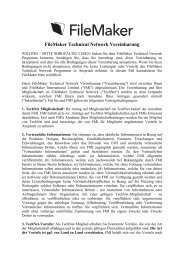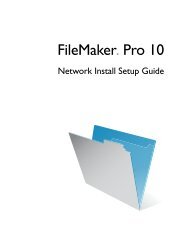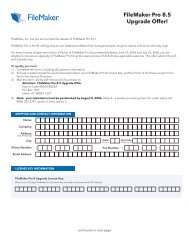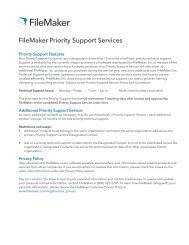FileMaker Server Guide to Updating Plug-ins
FileMaker Server Guide to Updating Plug-ins
FileMaker Server Guide to Updating Plug-ins
Create successful ePaper yourself
Turn your PDF publications into a flip-book with our unique Google optimized e-Paper software.
To change the permissions for plug-in files on a Mac OS server:<br />
Chapter 1 | Setting up Au<strong>to</strong> Update in your database 11<br />
1. Launch the Terminal application ([hard disk]/Applications/Utilities/Terminal).<br />
2. Navigate <strong>to</strong> the parent folder of the file or folder whose permissions you intend <strong>to</strong> change and enter the<br />
following at the command line:<br />
chmod g+rx <br />
or<br />
chmod g+wrx <br />
The g+rx is necessary because scripts and plug-<strong>ins</strong> must have the group read and executable bits<br />
enabled. Use the g+wrx form <strong>to</strong> permit write permission as well. Some plug-<strong>ins</strong> or scripts that use<br />
preferences or folders of additional files may require write permission <strong>to</strong> those files or folders.<br />
Setting up Au<strong>to</strong> Update in your database<br />
There are several ways <strong>to</strong> set up Au<strong>to</strong> Update in your database. This guide describes one way, which uses<br />
simple script steps and global fields, and is based on the sample file named Au<strong>to</strong>Update<strong>Plug</strong>in.fp7 <strong>ins</strong>talled<br />
with <strong>FileMaker</strong> <strong>Server</strong>.<br />
Overview<br />
To set up plug-in version checking in your database, you need <strong>to</strong> write a few simple script steps that run<br />
when a client opens your database. The first directs <strong>FileMaker</strong> Pro <strong>to</strong> a start-up layout, which conta<strong>ins</strong> global<br />
fields that s<strong>to</strong>re version information about your database’s plug-in requirements. This script calls a script<br />
named Run <strong>Plug</strong>-in Scripts, which calls sub-scripts that check for the required plug-in on both the client and<br />
server computers, collects version numbers of plug-<strong>ins</strong> that exist in these locations, compares them, and<br />
downloads an updated plug-in from the server, if needed.<br />
To set up plug-in version checking in your database<br />
1. Open your database using <strong>FileMaker</strong> Pro and enable the Au<strong>to</strong> Update plug-in in the Preferences dialog<br />
box.<br />
Note Remind the server administra<strong>to</strong>r <strong>to</strong> turn on Au<strong>to</strong> Update in the <strong>FileMaker</strong> <strong>Server</strong> Admin Console,<br />
Database <strong>Server</strong> > <strong>FileMaker</strong> Pro Clients tab, <strong>to</strong> allow <strong>FileMaker</strong> Pro clients <strong>to</strong> download updates<br />
au<strong>to</strong>matically.<br />
2. Create a layout <strong>to</strong> contain:<br />
1 fields defined with the global s<strong>to</strong>rage option <strong>to</strong> collect plug-in version information or result codes<br />
1 a but<strong>to</strong>n <strong>to</strong> manually run the script that creates a plug-in version information file for s<strong>to</strong>rage on the<br />
server<br />
For an example layout that conta<strong>ins</strong> all the fields and the but<strong>to</strong>n you need, see the STARTUP layout in<br />
the Au<strong>to</strong>Update<strong>Plug</strong>in.fp7 sample file.<br />
3. Write a script that uses the FMSAUC_Version function, which returns the name and version of the Au<strong>to</strong><br />
Update plug-in available in <strong>FileMaker</strong> Pro. If the name and version string is not returned, <strong>FileMaker</strong> Pro<br />
assumes the Au<strong>to</strong> Update plug-in is missing or isn’t enabled on the client computer.
















